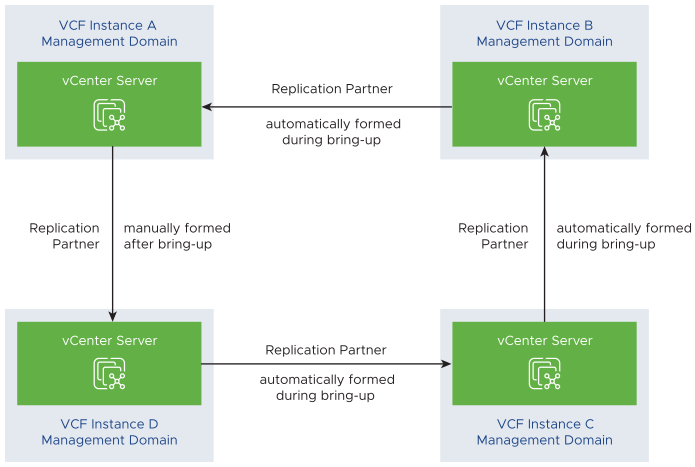Enhanced Linked Mode (ELM) improves the manageability of the environment. By using Enhanced Linked Mode of vCenter Server, you can log in to all vCenter Server instances that are joined to the same vCenter Single Sign-on domain and access their inventories. Enhanced Linked Mode also replicates all global permissions, licenses, policies, and tags between the linked vCenter Server instances.
You can join up to 15 vCenter Server instances to a single vCenter Single Sign-On domain.
Design Component |
ELM across VMware Cloud Foundation Instances |
ELM within a VMware Cloud Foundation Instance |
Considerations |
|---|---|---|---|
Manageability |
↑↑ |
↓ |
You join all vCenter Server instances across all VMware Cloud Foundation instances in one vCenter Single Sign-On domain for improved manageability. You replicate all global permissions, licenses, policies, and tags, and you can view the inventories of all vCenter Server instances. |
Scalability |
↓↓ |
↑↑ |
Each VMware Cloud Foundation instance can have a separate vCenter Single Sign-On domain for improved scalability. By following this approach, you can deploy up to 15 domains per VMware Cloud Foundation instance, compared to a total of 15 domains across all VMware Cloud Foundation instances if you share a vCenter Single Sign-On domain between all VMware Cloud Foundation instances. |
If manageability of virtual infrastructure is a priority for your organization, use a shared vCenter Single Sign-On domain when deploying multiple VMware Cloud Foundation instances, considering the limitation in the maximum number of workload domains. Alternatively, as a compromise between manageability and scalability requirements, you can also use a different vCenter Single Sign-On domain per VMware Cloud Foundation instance.
To activate nhanced Linked Mode in the management domain across VMware Cloud Foundation instances, you must join the management domain of each additional VMware Cloud Foundation instance to the existing vSphere Single Sign-On domain during bring-up to form a ring topology.
When more than two instances of VMware Cloud Foundation are joined, you must manually configure in vCenter Server the replication partner between the first and last vCenter Server instances to form a complete ring topology.

Decision ID |
Design Decision |
Design Justification |
Design Implication |
|---|---|---|---|
VCF-MGMT-VCS-CFG-004 |
Join all vCenter Server instances to a single vCenter Single Sign-On domain. |
When all vCenter Server instances are in the same vCenter Single Sign-On domain, they can share authentication and license data across all components and VMware Cloud Foundation instances. |
|
VCF-MGMT-VCS-CFG-005 |
Create a ring topology between the vCenter Server instances for the management domains. |
By default, one vCenter Server instance replicates only with another vCenter Server instance. This setup creates a single point of failure for replication. A ring topology ensures that each vCenter Server instance has two replication partners and removes any single point of failure. |
None. |